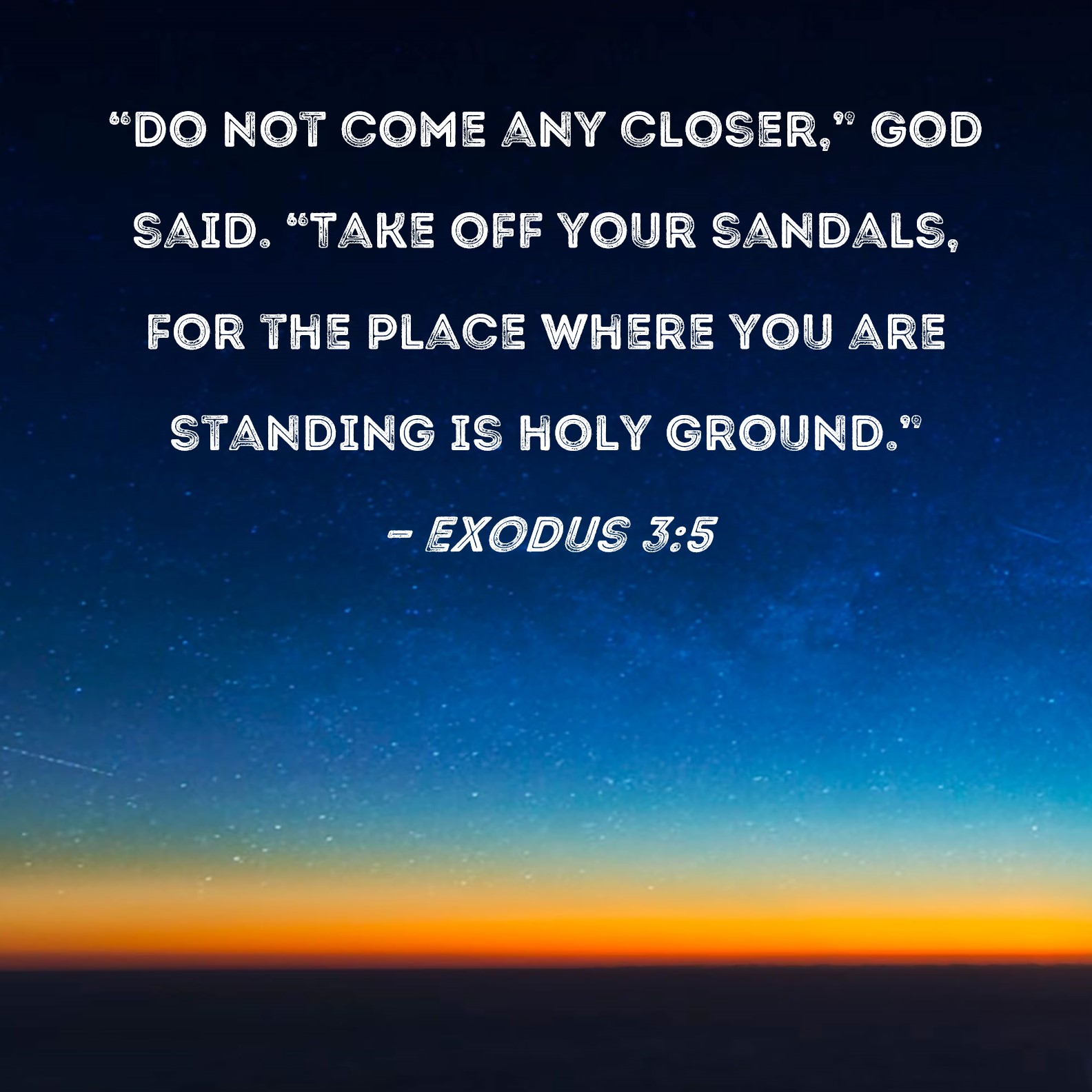God told Joshua to take off his shoes because he stood on holy ground. This moment marked a sacred encounter between Joshua and God.
In the Bible, moments like this hold deep meaning. Joshua, a leader of the Israelites, found himself in a profound situation. Removing his shoes was a sign of respect and humility. It showed Joshua’s recognition of God’s presence. Such acts are common in many religious traditions.
They symbolize purity and reverence. Understanding this moment helps us appreciate the importance of respect in spiritual practices. Join us as we explore the deeper meanings behind God’s command to Joshua. This story offers insight into faith and obedience.

Credit: wellspringchristianministries.org
Joshua’s Encounter With God
Joshua had a profound encounter with God. This event marked a significant moment in his leadership. It also held deep spiritual meaning. One of the key moments was when God told Joshua to take off his shoes. This command might seem simple, but it was powerful.
Biblical Context
The Bible details Joshua’s journey and his role. Joshua was Moses’ successor. He led the Israelites into the Promised Land. This event took place after Moses’ death. God chose Joshua to continue the mission. The encounter happened near Jericho. This was a crucial time for the Israelites.
Location And Setting
The setting of this encounter is significant. Joshua was near Jericho, preparing for battle. The land was promised to the Israelites. Joshua met a man with a drawn sword. This man revealed himself as the commander of the Lord’s army. This place became holy ground.
God commanded Joshua to remove his sandals. This act was a sign of respect. It showed Joshua’s submission to God. The ground he stood on was holy. This event reminded Joshua of his sacred mission. The location and setting highlighted the importance of obedience to God.
Symbolism Of Removing Shoes
God asked Joshua to remove his shoes as a sign of respect and humility. This act symbolized entering holy ground. It showed acknowledgment of God’s presence and authority.
Joshua’s story is full of rich symbolism. One significant event is God asking Joshua to remove his shoes. This act carries deep meaning and has layers of symbolism. It reflects cultural, spiritual, and historical contexts. Let’s explore these layers.Cultural Practices
In ancient times, removing shoes had cultural importance. It showed respect and reverence. People took off their shoes in sacred places. This practice is still present in many cultures today. Removing shoes signified entering a holy space. It was an act of humility and honor.Spiritual Meaning
The act of removing shoes also has spiritual symbolism. Shoes protect our feet, but they also carry dirt. By removing them, Joshua showed purity. He acknowledged the holiness of the ground. This act demonstrated his submission to God’s authority. It was a sign of respect and readiness to serve. Joshua’s obedience in removing his shoes set a powerful example. It showed his willingness to follow God’s commands. This act symbolized a deeper spiritual cleansing. It was a moment of reverence and commitment. Joshua’s action reminds us of the importance of humility before God. “`Holiness And Reverence
The story of Joshua taking off his shoes is rich with meaning. This act symbolized holiness and reverence in the presence of God. Understanding this gesture helps us appreciate the sacredness of certain moments and places in our lives.
Concept Of Holy Ground
Holy ground refers to places set apart for God’s presence. In Joshua’s case, the ground was holy because God was there. The act of removing shoes showed respect for this divine presence. It acknowledged that the ground was not ordinary.
Throughout the Bible, holy ground represents a special encounter with God. It is a place where heaven meets earth. Such places demand a response of awe and reverence. By taking off his shoes, Joshua recognized God’s holiness.
Expressions Of Respect
Removing shoes is a common sign of respect in many cultures. It symbolizes humility and submission. In Joshua’s time, this act showed obedience and honor to God. It was a physical way to demonstrate inner reverence.
Other expressions of respect include bowing or kneeling. These actions reflect a heart attitude of humility. They remind us of our place before a holy and powerful God. By practicing these gestures, we show our reverence for His presence.
Joshua’s act of removing his shoes teaches us the importance of reverence. It reminds us to honor God’s holiness in our lives. We too can express respect in our actions and attitudes, acknowledging His presence in everything we do.
Lessons For Believers
Understanding why God told Joshua to take off his shoes offers deep lessons for believers. These lessons guide believers in their spiritual journey. They help in developing a closer relationship with God.
Humility And Obedience
God’s command to Joshua to remove his shoes was a call for humility. Shoes symbolize protection and separation from the ground. By removing them, Joshua showed his vulnerability. He acknowledged God’s authority over him. This act demonstrated his obedience and respect for God’s holiness.
Believers can learn from Joshua’s humility and obedience. It reminds them to submit to God’s will without question. It teaches them to trust in God’s plan, even if they don’t understand it fully.
Awareness Of God’s Presence
Removing shoes in sacred places was a sign of reverence. It showed awareness of God’s presence. When Joshua stood barefoot, he recognized that he was on holy ground. This act heightened his awareness of God’s divine presence.
Believers today must cultivate an awareness of God’s presence in their lives. It helps them to live with a sense of reverence and respect. It encourages them to seek God’s guidance in every aspect of their lives.
Comparison With Moses
In the Bible, both Moses and Joshua had profound encounters with God. One of the key moments in Joshua’s life was when God told him to take off his shoes. This event draws a strong parallel with Moses’ own divine encounter with the burning bush. Let’s delve into the similarities and differences between these two significant moments.
Similar Divine Encounters
Both Moses and Joshua experienced direct communication with God. In Moses’ case, God spoke to him from a burning bush. For Joshua, the encounter happened near Jericho when he saw a man with a drawn sword.
- Moses: Burning bush on Mount Horeb
- Joshua: Man with a drawn sword near Jericho
In both cases, God instructed them to remove their shoes. This act signified the holiness of the ground where they stood. Removing shoes is a sign of reverence and respect.
They were both chosen leaders of Israel. Moses led the Israelites out of Egypt. Joshua led them into the Promised Land.
Differences And Parallels
| Aspect | Moses | Joshua |
|---|---|---|
| Location | Mount Horeb | Near Jericho |
| Divine Appearance | Burning Bush | Man with a drawn sword |
| Task | Lead Israelites out of Egypt | Lead Israelites into the Promised Land |
While Moses’ encounter was at the start of his journey, Joshua’s was at a pivotal moment. Moses was called to deliver the Israelites, while Joshua was tasked with conquering the Promised Land.
Both leaders were given divine instructions that changed their lives. Moses faced Pharaoh, while Joshua faced the fortified city of Jericho.

Credit: biblehub.com
Theological Interpretations
Understanding why God told Joshua to take off his shoes can be complex. Different theological interpretations offer various insights into this divine instruction. Let’s explore these perspectives.
Scholarly Perspectives
Scholars have long debated the significance of this command. Many believe it signifies reverence and respect. Removing shoes is a gesture of humility and purity. It shows acknowledgment of the sacredness of the moment.
Other scholars suggest it symbolizes obedience. Joshua’s immediate compliance highlights his readiness to serve and follow God’s directives. This act can be seen as a physical manifestation of spiritual devotion.
Furthermore, some interpretations link this event to ancient customs. In many cultures, removing shoes when entering a holy place is a common practice. This command to Joshua could reflect a similar tradition, emphasizing the sanctity of the encounter.
Different Denominational Views
Denominational views on this event vary. Here are a few perspectives:
| Denomination | Interpretation |
|---|---|
| Evangelical | Focus on the personal relationship with God. Emphasizes obedience and humility. |
| Catholic | Highlights the sacred tradition. Connects to broader liturgical practices of reverence. |
| Orthodox | Stresses the holiness of God’s presence. Links to historical and cultural practices of removing shoes. |
These varied interpretations show the richness of theological thought. Each perspective adds depth to our understanding of Joshua’s encounter with God.
Modern Relevance
The story of God telling Joshua to take off his shoes is profound. It holds significant lessons even today. This ancient command has modern relevance that can enrich our lives.
Application In Daily Life
Taking off shoes is about respect and humility. In our daily lives, we can practice humility in various ways:
- Listening more
- Helping others
- Admitting mistakes
These actions show respect for others and ourselves. They promote a peaceful environment.
Cultural Adaptations
Different cultures have unique ways of showing respect. Removing shoes is common in many Asian households. It symbolizes cleanliness and reverence. In other cultures, people bow or greet with specific gestures. Understanding and respecting these customs can build stronger relationships.
Here’s a table showing examples from various cultures:
| Culture | Respectful Gesture |
|---|---|
| Japanese | Bowing |
| Middle Eastern | Hand on heart |
| Western | Firm handshake |
Adapting to these practices shows we value and understand others’ traditions. It fosters mutual respect and harmony.

Credit: www.thetorah.com
Frequently Asked Questions
Why Did God Tell Joshua To Remove His Shoes?
God told Joshua to remove his shoes because the ground was holy. It showed respect and reverence.
What Is The Significance Of Removing Shoes In The Bible?
Removing shoes in the Bible shows humility and respect. It signifies entering a holy or sacred place.
Where Did God Tell Joshua To Take Off His Shoes?
God told Joshua to take off his shoes near Jericho. It was during his encounter with the angel.
Conclusion
Understanding why God told Joshua to take off his shoes reveals respect. It shows humility before the divine. This act signifies sacred ground and a holy moment. God wanted Joshua to realize the importance. Respecting holy places is a timeless lesson.
It reminds us to honor what is sacred. We, too, can learn from Joshua’s experience. Showing reverence in our lives holds value. Simple acts can carry deep meanings. Stay mindful and respectful in all you do. This lesson is relevant even today.



Leave a Reply